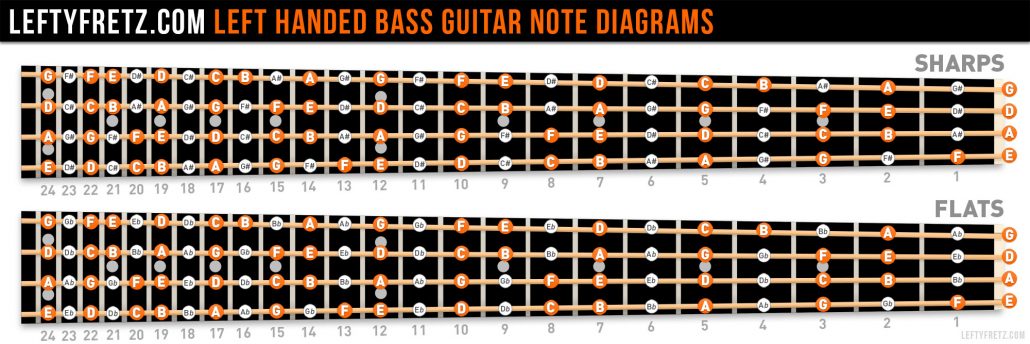Learning the notes on your new lefty bass is a good idea – nay, a GREAT idea! Luckily for you, I’ve put together this handy dandy left handed bass fretboard notes diagram. You’re welcome!
Looking for a version of this diagram for your 6-string guitar? We have one of those too! Click here for the guitar chart.
Left Handed Bass Fretboard Notes Diagram
The image below is merely a small preview of the full-sized chart. Unless you’re some weirdo who enjoys killing your eyeballs, click on the image to enlarge, or if you’d prefer – click here. Print it, make it your desktop background, burn it into your mind – after all, this information could potentially save your life one day. Maybe…
Music Theory 101
Before we start to learn the notes, we’ll consider some very basic music theory that you’ll need to know.
There are 7 ‘whole notes’ in music – A,B,C,D,E,F and G
Between (most of) these whole notes we also have either flat (b) or sharp (#) notes.
A – A#/Bb – B – C – C#/Db – D – D#/Eb – E – F – F#/Gb – G – G#/Ab.
Flats and sharps are just different names for the same notes (this is called enharmonic). For example, notice in the sequence above that an F# is exactly the same as a Gb. The difference is that when ascending the fretboard you’ll use sharps, and when descending you’ll use flats. Simple!
The distance between two whole notes is referred to as a ‘whole step’. The distance between a whole note and a sharp/flat note is a ‘half-step’. So again, looking at the sequence above, D# is a half-step above D, or Eb is a half-step below E. Be sure to notice that the jump from B to C, and also E to F is a half-step increment, as there are no sharps/flats between them.
The sequence of notes above is the order of the notes that you’ll find on every string. So your primary job should be memorising this progression, as once you have it under your skin, you’ll be able to figure out any note on the fretboard. Happy days!
Learning The Notes
Let’s start with the absolute basics – you know that your bass is tuned E-A-D-G from low to high, right? If you don’t, read how to tune a left handed guitar right now.
So, you know that the open strings are E, A, D and G – good! By default you now also know the notes at the 12th fret (and the 24th, if your bass has that many frets!). This is because all of the notes repeat themselves from the 12th fret onwards. Because the notes are repeated, this means that you only have to learn frets 1 to 11, and then you know the entire fretboard by default.
A good idea is to try and learn the strings one at a time, so as not to overwhelm yourself. Start of by just learning the whole notes, as once you’ve memorised those, it’s easy to fill in the gaps with flats or sharps. It shouldn’t take too long to master the entire fretboard.
Try using octaves to make learning each string much quicker. Take a look at the 5th fret on the E-string (an A), and then notice that you’ll find another ‘A’ on the D-string two frets higher. Memorise this shape (two strings up and two frets along) to be able to quickly identify notes on the two higher strings.
If you decide to take up 6-string guitar later on, it will be super easy to learn the notes as you’ll only need to master one extra string!
Extra Reading
I haven’t put together a great deal in terms of left handed bass tuition materials (yet), so in the meantime why not check out the useful books below for your next task?
Head to the Lessons section for more tuition materials


